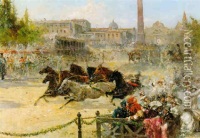Augusto Alberici Paintings
Augusto Alberici was an Italian sculptor who was born on July 15, 1863, in Montottone, Marche, Italy. He showed a talent for art from an early age and pursued his passion for sculpture as he grew older. Although not as widely known as some of his contemporaries, Alberici contributed significantly to the art world during his lifetime, particularly in the realm of decorative sculpture, which was popular during the late 19th and early 20th centuries.
Alberici's work is characterized by its intricate detail and classical style, often drawing inspiration from ancient Greek and Roman art, as well as the Renaissance masters. He had a penchant for creating figures that exuded a sense of elegance and grace. His sculptures were not only appreciated in Italy but also gained recognition abroad, especially in the United States where he spent a significant part of his career.
In the early 1900s, Alberici moved to the United States, where he became part of the vibrant community of Italian artists and craftsmen who contributed to the American Beaux-Arts architecture and sculpture scene. He worked on numerous commissions, both public and private, which included architectural sculptures, memorials, and decorative pieces.
Among his notable works is the sculpture for the Marconi Memorial in Washington, D.C., which showcases his ability to create lifelike portraits and his mastery over bronze as a medium. His other works can be found in various collections and public spaces, bearing testament to his skill and artistic legacy.
Augusto Alberici's contributions to the field of sculpture were cut short when he passed away on October 18, 1928. Despite not being a household name, his work continues to be studied and appreciated by art historians and enthusiasts who have a particular interest in the period's sculpture. Alberici’s artistic endeavors during his time in America also reflect the broader story of immigrant artists who played a crucial role in shaping the country's artistic landscape in the early 20th century.








